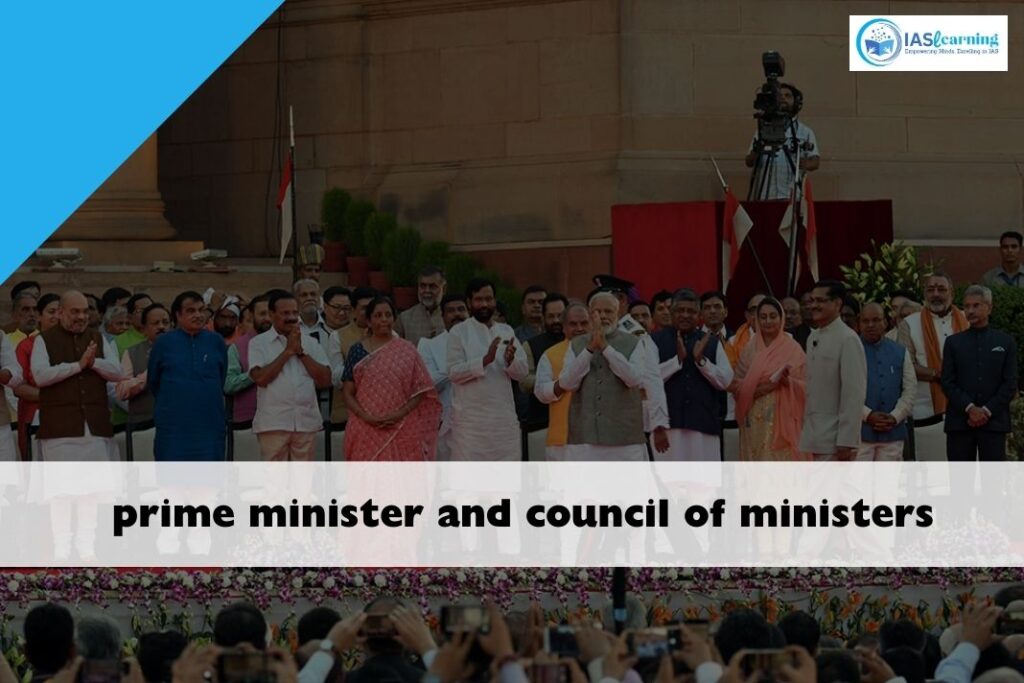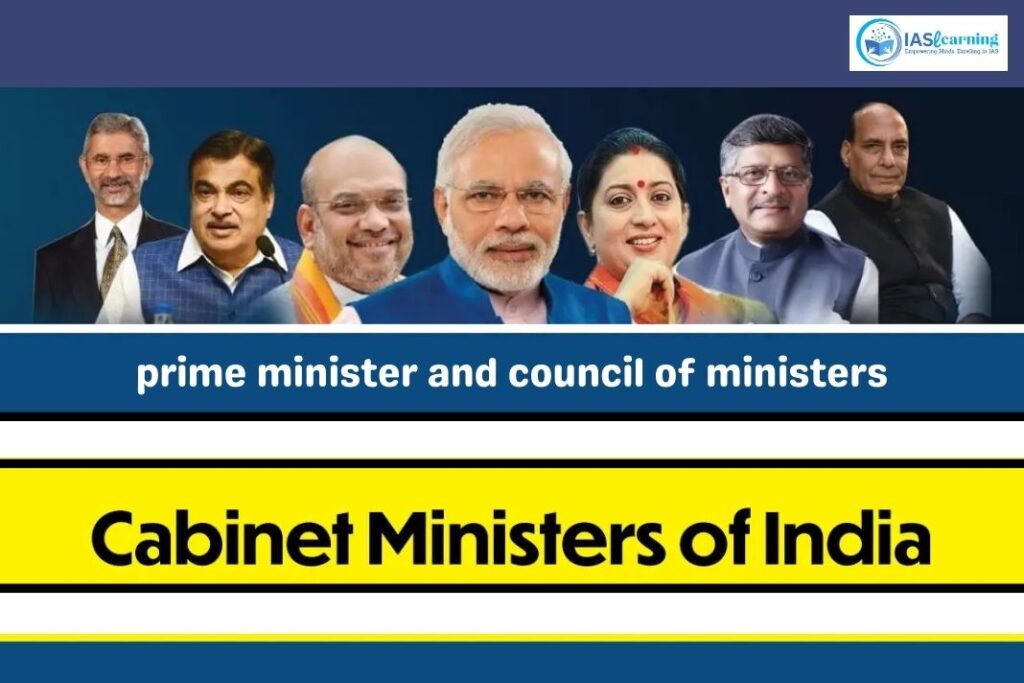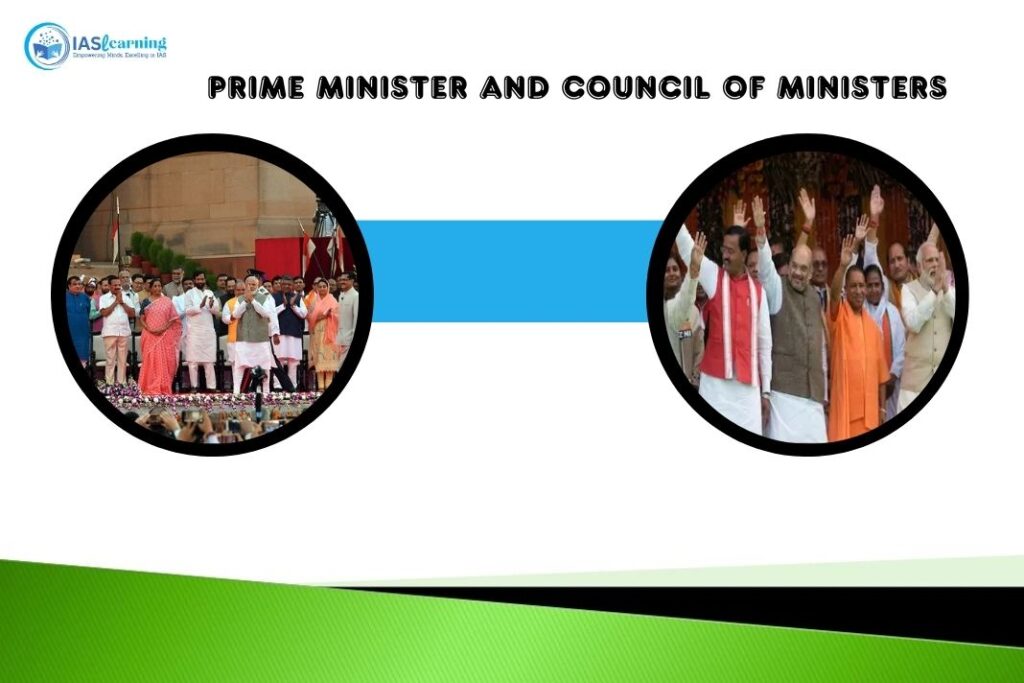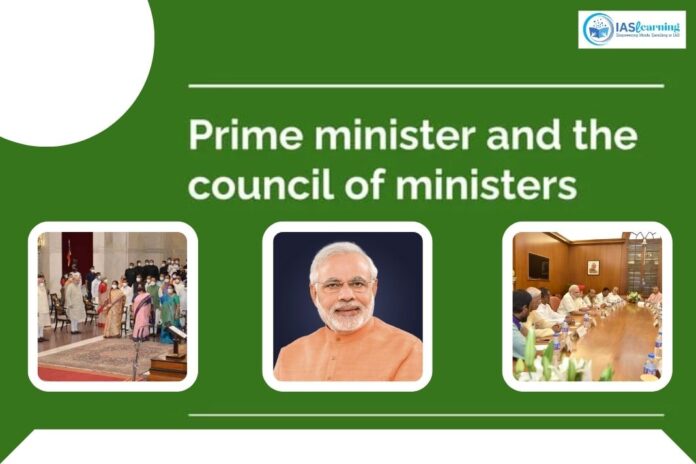Prime Minister & Council of Ministers
Article 75 of the Indian Constitution pertains to the appointment of the Prime Minister. It states that the Prime Minister shall be appointed by the President and other ministers shall be appointed by the President on the advice of the Prime Minister. The Prime Minister is the head of the Council of Ministers and is responsible for aiding and advising the President in the exercise of his functions.
Article 74(1) mentions the existence of a Council of Ministers with the Prime Minister at the head to aid and advise the President. However, the Prime Minister and other ministers are appointed by the President.
The process of the Prime Minister’s appointment involves the leader of the majority party in the Lok Sabha being invited by the President to form the government. The President appoints other ministers on the advice of the Prime Minister. The Prime Minister is not directly elected by the people; instead, they emerge from the political party or coalition with a majority in the Lok Sabha.
This clarification is essential for those preparing for the IAS Exam to ensure accurate and up-to-date information is provided. It’s recommended to refer to the latest editions of constitutional law books and official documents for the most recent and precise details regarding the Indian Constitution and the appointment of the Prime Minister and Council of Ministers.

- Introduction
- Provide a brief overview of the Prime Minister and Council of Ministers’ roles in the Indian political system.
- Appointment Process of the Prime Minister
- Explain how the Prime Minister is chosen, detailing the involvement of the President and the leader of the majority party in the Lok Sabha.
- Role and Responsibilities of the Prime Minister
- Delve into the powers and duties of the Prime Minister, covering their executive, legislative, and administrative functions.
- Historical Prime Ministers of India
- Explore the list of past Prime Ministers, highlighting their contributions and historical significance.
- Constitutional Relationship between the Prime Minister and the President
- Examine the constitutional dynamics between the Prime Minister and the President, emphasizing the advisory role of the Council of Ministers.
- Structure and Functions of the Council of Ministers
- Provide an in-depth analysis of the Council of Ministers’ composition, roles of various ministers, and their collective responsibility.
- Challenges and Criticisms
- Analyze any difficulties or criticisms faced by the Prime Minister and Council of Ministers within the Indian political landscape.
- Reforms and Amendments
- Discuss significant reforms or amendments related to the Prime Minister’s office and the Council of Ministers.
Is the Prime Minister of India Elected or Appointed?

The President of India appoints an individual as the Prime Minister, who is either the leader of the party holding a majority of seats in the Lok Sabha or a person capable of securing the confidence of the Lok Sabha by garnering support from other political parties. The appointment of all other ministers is made by the President on the advice of the Prime Minister.
It is noteworthy that the President can exercise the discretion to appoint the Prime Minister independently, but this is only applicable when no political party commands a clear majority in the Lok Sabha.
Power and Function of the Prime Minister:
- Leader of the Country:
- The Prime Minister of India serves as the Head of the Government.
- Portfolio Allocation:
- The Prime Minister possesses the authority to assign portfolios to the Ministers.
- Chairman of the Cabinet:
- Serving as the chairman of the cabinet, the Prime Minister presides over cabinet meetings and has the ability to enforce decisions in case of significant differences of opinion among its members.
- Official Representative of the Country:
- The Prime Minister represents the country in high-level international meetings.
- Link Between the President and the Cabinet:
- Acting as the intermediary between the President and the cabinet, the Prime Minister communicates all cabinet decisions to the President, particularly those pertaining to the administration of Union affairs and proposals for legislation.
- Head:
- The Prime Minister holds the position of the head in various significant entities, including the Nuclear Command Authority, NITI Aayog, Appointments Committee of the Cabinet, Department of Atomic Energy, Department of Space, and Ministry of Personnel, Public Grievances, and Pensions.
- Chief Advisor:
- The Prime Minister serves as the chief advisor to the President.
Additionally, akin to the Prime Minister being the head of the Union Parliament, the Chief Minister assumes the role of the head of the state parliament.
Eligibility for the Position of Prime Minister:
To be eligible for the position of Prime Minister in India, an individual must meet the following criteria:

- Citizenship:
- The candidate must be a citizen of India.
- Membership in Parliament:
- The candidate should be a member of either the Rajya Sabha (Council of States) or the Lok Sabha (House of the People).
- Age Requirement:
- If a candidate is a member of the Rajya Sabha, they should have attained the age of 30 years. Alternatively, if the candidate is a member of the Lok Sabha, the minimum age requirement is 25 years.
Position of the Prime Minister:
The role and position of the Prime Minister in India hold significant importance. Here are key aspects of the Prime Minister’s position:
- Leadership in the Cabinet:
- The Prime Minister holds a commanding position in the Cabinet, leading the executive branch of the government.
- Leader of the Majority Party:
- The Prime Minister is the leader of the majority party in the Parliament, further enhancing their influence and authority.
- Preeminence in Governance:
- The combined authority of being the head of the government and the leader of the majority party elevates the Prime Minister to a preeminent position in governance.
- Impact on Council of Ministers:
- The death or resignation of the Prime Minister automatically leads to the dissolution of the entire Council of Ministers. This occurrence creates a void, and the government cannot operate without a Prime Minister.
- Vacancy vs. Ministerial Changes:
- While the demise, resignation, or dismissal of a Minister creates only a vacancy that may or may not be filled by the Prime Minister, the absence of a Prime Minister disrupts the functioning of the government.
In summary, the eligibility criteria, coupled with the unique powers and position of the Prime Minister, make this role pivotal in the Indian political landscape.
Relationship Between the Prime Minister and the President of India:
The interaction between the Prime Minister and the President in India is delineated by various constitutional articles:
- Article 74:
- Expounds on the association among the Prime Minister, President, and the Council of Ministers. It establishes that the Council, under the Prime Minister’s leadership, advises the President on diverse matters.
- Article 75:
- Enumerates three pivotal elements:
- The President designates the Prime Minister, and other ministers are appointed by the President based on the Prime Minister’s counsel.
- Ministers serve at the discretion of the President.
- The Council of Ministers is collectively accountable to the Lok Sabha.
- Enumerates three pivotal elements:
- Article 78:
- Emphasizes that the Prime Minister conveys all decisions of the Council of Ministers to the President. Additionally, the President can refer issues for the Council of Ministers’ consideration.
This constitutional framework establishes a dynamic relationship, where the President appoints the Prime Minister and ministers, and the Prime Minister, through the Council of Ministers, provides guidance to the President.
Facts about Indian Prime Ministers for UPSC:
For UPSC 2023 aspirants, here are noteworthy details about Indian Prime Ministers that may prove beneficial in UPSC Mains:
- Longest-Serving Indian Prime Minister:
- Jawaharlal Nehru (1947 – 1964)
- Second Longest-Serving Indian Prime Minister:
- Indira Gandhi
- Acting Prime Minister Twice:
- Gulzari Lal Nanda
- First Woman Prime Minister to Receive the Bharat Ratna:
- Indira Gandhi
- First Non-Congress Prime Minister of India:
- Morarji Desai
- Indian Prime Minister Received Pakistan’s Highest Civilian Award:
- Morarji Desai
- Youngest Indian Prime Minister:
- Rajiv Gandhi
- First Prime Minister from South India:
- P.V. Narasimha Rao
- First Prime Minister of India who was a Member of the Rajya Sabha:
- Indira Gandhi
These historical insights offer a broader perspective on India’s political history and are valuable for UPSC exam readiness.

Council of Ministers in the Indian Constitution:
The constitutional framework regarding the Council of Ministers is outlined in two pivotal articles – Article 74 and Article 75:
- Article 74:
- Specifies that the Council of Ministers is to be headed by the Prime Minister of India. Its primary function is to aid and advise the President in the exercise of his functions.
- Article 75:
- Outlines key aspects of the Council of Ministers, including:
- Appointment by the President on the advice of the Prime Minister.
- The Council, including the Prime Minister, constitutes 15% of the total strength of the Lok Sabha, and this number cannot exceed 15%.
- The 91st Amendment Act introduces provisions for the disqualification of a minister if they are disqualified as a Member of Parliament.
- A Minister ceases to hold office if not a member of either house of Parliament for six consecutive months.
- Parliament determines the salary and allowances of the Council of Ministers.
- Outlines key aspects of the Council of Ministers, including:
This constitutional foundation defines the composition, appointment, and functioning of the Council of Ministers, elucidating its integral role in the governance structure of India.

